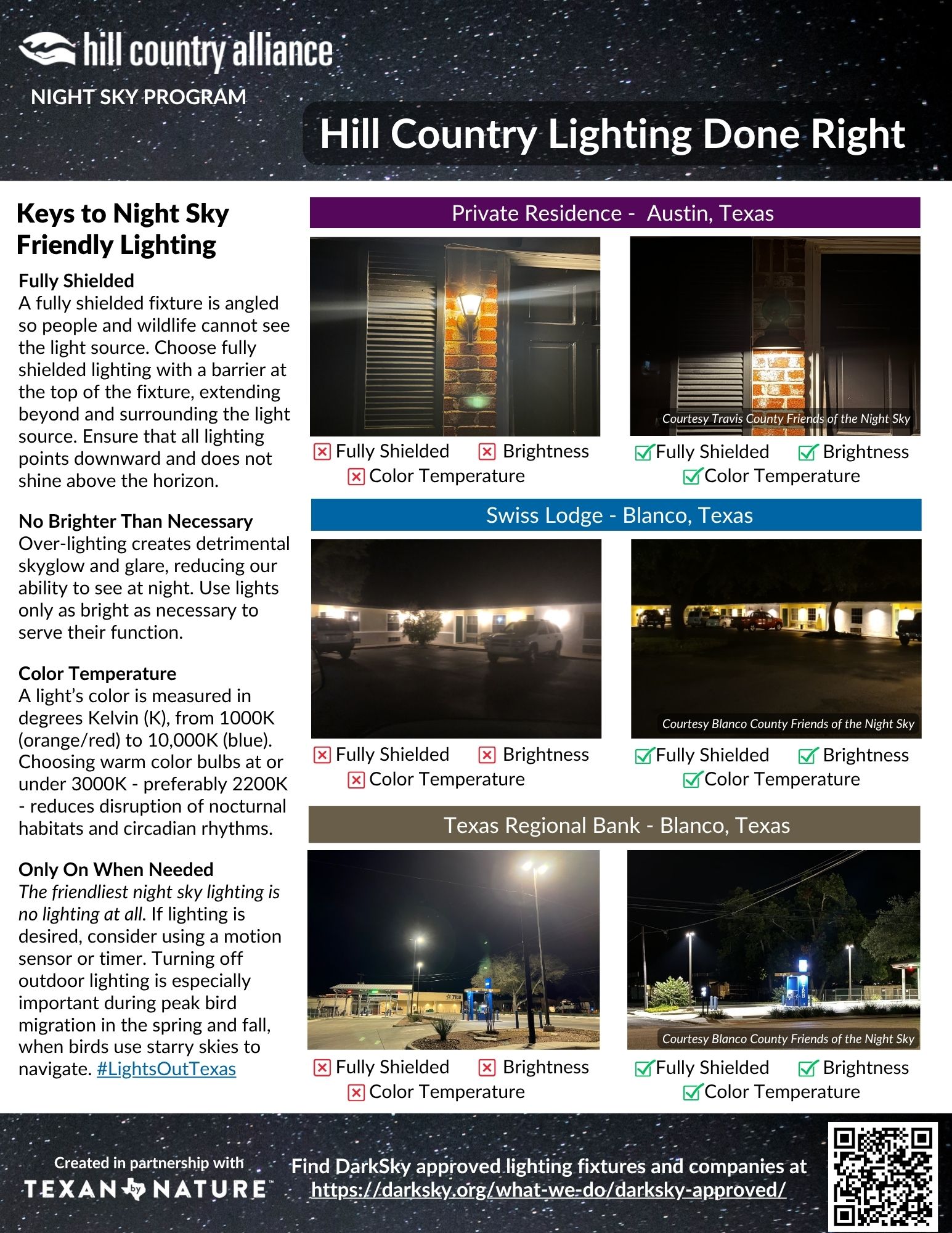Night Sky Friendly Lighting
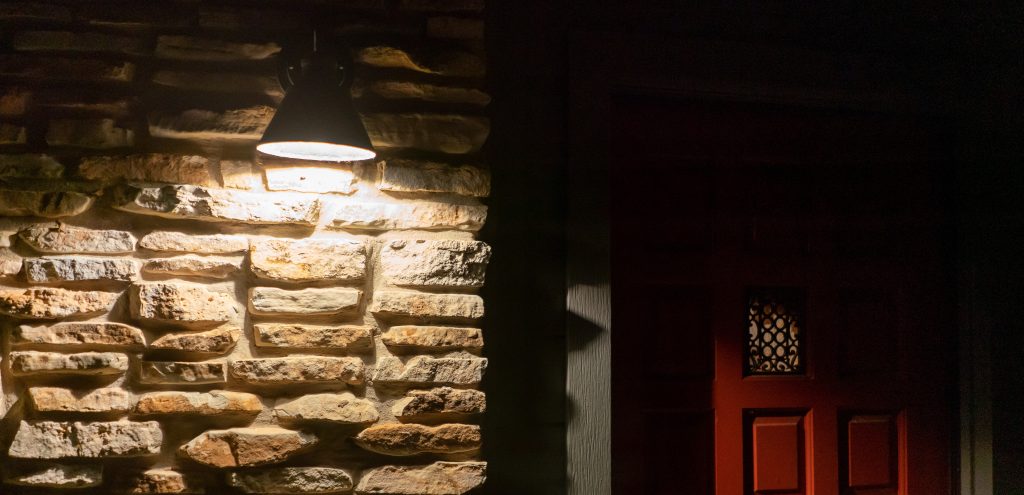
Good Lighting Enhances Good Views
Restoring the stars’ brilliance against an unpolluted sky and reducing the harmful impacts of light pollution can be accomplished through properly designed and installed outdoor lighting. Simple downlighting and shielding techniques can reduce glare, light trespass (light shining across property lines) and sky glow (hazy, amber or pink sky on cloudy nights) while improving safety, security, and the enjoyment of property.
Night Sky Friendly Lighting is:
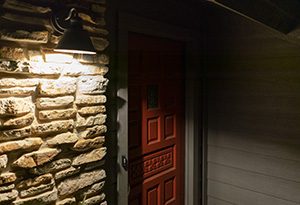
Photo: JHJackson Photography
Fully shielded
Fully shielded lighting has a barrier at both the top of the fixture and surrounding the light bulb or LED light source. A fully shielded fixture is angled so the light source cannot be seen by nearby people or wildlife. Fully shielded lighting prevents light trespass onto your neighbors’ property while also preventing glare and skyglow.
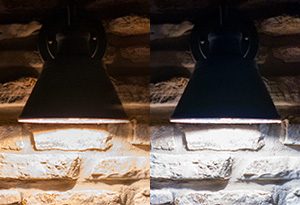
Photo: JHJackson Photography
The correct color temperature
Color temperature describes the apparent color of the light emitted from a light source. It is measured in degree Kelvin (K) on a scale from 1,000 to 10,000. Lower color temperature light, or light with Kelvin ranges from 2,000K to 3,000K, has less blue light in its spectrum and so we call this light ‘warm’. Higher color temperature light, or light with Kelvin ranges from 3,100 to 6,500, is rich in blue light. It appears harsher and brighter, and creates more glare and sky glow. Blue light has also been shown to harm our health and endanger wildlife.
For all of these reasons, it is critical for the light we use to be on the ‘warm’ end of the spectrum. The International Dark Sky Association recommends using lighting that has a color temperature of no more than 3,000 Kelvin – the lower the better.

Photo: Mike Weasner
No brighter than necessary
Good outdoor lighting has a specific purpose. It may be to light a path, doorway, or a sign. Whatever the purpose, it is important that the light is no brighter than necessary to serve that function. Over-lighting creates more skyglow and glare, while also diminishing our ability to actually see at night. When it comes to outdoor lighting – in most cases – less is more.
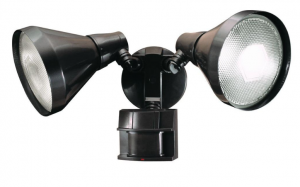
Photo: Homedepot.com
Only on when needed
Using light when not needed is wasteful and inconsiderate of neighbors. Studies have shown that there are also huge economic and environmental consequences of wasted light on a national level. Regardless of whether you are actively using outdoor lights that remain on overnight – you are paying for it! Thankfully, night time lighting can be used when needed and still allow you to stay safe in the dark. For more information on when best to use outdoor lighting at night, check the dropdown resources below.
Additional Information on Night Sky Friendly Lighting
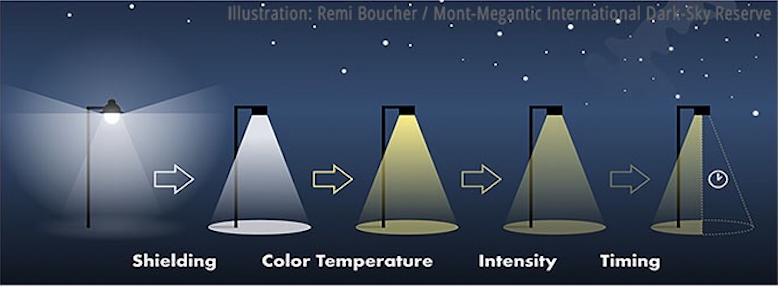
Light Shielding
Fixture Seal of Approval – International Dark Sky Association
Lighting Assessment & Retrofit Project Training Manual
Community Friendly Outdoor Sports Lighting program – International Dark Sky Association
Color Temperature
Glare
Only On When Needed
Conducting a Lighting Assessment
Recent Night Sky News
Hill Country Dark Sky Conference shines light on night sky preservation
Annual Event Returns to the Region, Uniting Leaders and Advocates to Combat Light Pollution Blanco, Texas – “Our skies are not just a backdrop; they are part of our heritage, our science, and our spirit,” said Mayor Candy Cargill of Blanco, who welcomed participants...
The Hill Country is celebrating the stars and night sky throughout October
The fifth annual Hill Country Night Sky Month is here. The October celebration affords people the chance to enjoy one of the region’s most beloved features, the star-filled sky. The Hill Country Alliance (HCA) and dozens of partners make this a community-wide event....
Shield Ranch Barton Creek named the first Urban Night Sky Place in Texas
DarkSky International officially certified Shield Ranch Barton Creek as an Urban Night Sky Place (UNSP). Shield Ranch joins three neighboring designated International Dark Sky Places; Dripping Springs and Bee Cave, Texas – both International Dark Sky Communities – and...
Shield Ranch Barton Creek named first Urban Night Sky Place in Texas
“Shield Ranch is Texas’s 20th International Dark Sky Place certified in the International Dark Sky Places program. In addition to three Developments of Distinction, there are now 23 internationally recognized sites in the state that have gone above and beyond in the...

